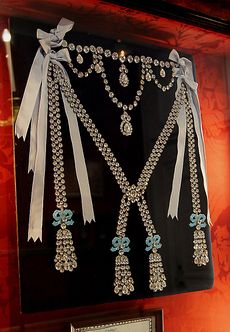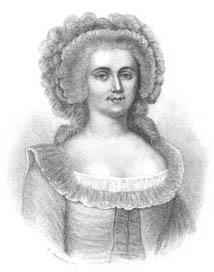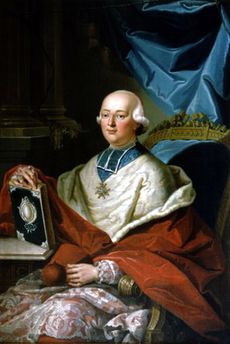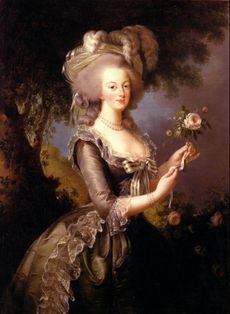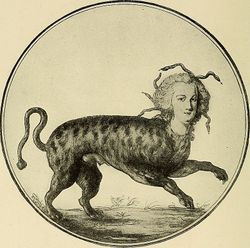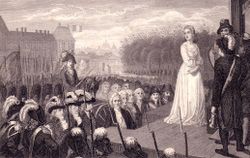Affair of the Diamond Necklace
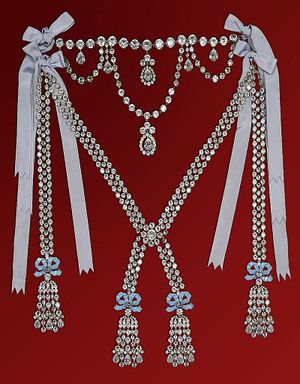
The Affair of the Diamond Necklace (French: Affaire du collier de la reine, "Affair of the Queen's Necklace") was an incident from 1784 to 1785 at the court of King Louis XVI of France that involved his wife, Queen Marie Antoinette.
The Queen's reputation, already tarnished by gossip, was further sullied by the false accusation that she had committed a crime to defraud the Crown's jewelers in acquiring a costly diamond necklace she then refused to pay for. She rejected the idea of buying it only to have her signature forged by Jeanne de Valois-Saint-Rémy. Although Jeanne was later convicted, the event remains historically significant as one of many that led to the French disillusionment with the monarchy, in that it was one of the contemporary scandals that gave moral weight and popular support for the French Revolution.
In 1772, Louis XV of France decided to make Madame du Barry, one of his mistresses, a special gift at the estimated cost of 2,000,000 livres (approximately US$15.1 million in 2021). He requested that Parisian jewelers Charles Auguste Boehmer and Paul Bassenge create a diamond necklace surpassing all others in grandeur.
It took the jewelers several years and a lot of money to amass an appropriate set of diamonds. In the meantime, Louis XV died of smallpox, and his grandson and successor banished Madame du Barry from the court.
It was described as "a row of seventeen glorious diamonds, as large almost as filberts... a three-wreathed festoon, and pendants enough (simple pear-shaped, multiple star-shaped, or clustering amorphous) encircle it... around a very Queen of Diamonds". The jewelers hoped it would be a product that the new Queen of France, Marie Antoinette, would buy and indeed in 1778 the new king, Louis XVI, offered it to his wife as a present, but she refused. The Queen initially turned it down, stating, "We have more need of Seventy-Fours [ships] than of necklaces." Some said that Marie Antoinette refused the necklace because it was created for du Barry, whom she strongly disliked. According to others, Louis XVI himself changed his mind.
After having vainly tried to place the necklace outside France, the jewelers again attempted to sell it to Marie Antoinette after the birth of Louis Joseph, Dauphin of France, in 1781. The Queen again refused.
Affair
A confidence trickster who called herself Jeanne de Valois-Saint-Rémy, also known as Jeanne de la Motte, planned to use the necklace to gain wealth, power, and royal patronage. A descendant of an out-of-wedlock son of Henry II of France, Jeanne had married an officer of the gendarmes, Nicholas de la Motte, the self-proclaimed "Comte de la Motte". She was living on a small pension that the King had granted her.
In March 1785, Jeanne became the mistress of the Cardinal de Rohan, a former French ambassador to the court of Vienna. Queen Marie Antoinette regarded the Cardinal with displeasure for having spread rumors about the Queen's behavior to her formidable mother, Holy Roman Empress Maria Theresa. The Queen had also learned of a letter in which the Cardinal spoke of Maria Theresa in a manner that the Queen found offensive.
The Cardinal then tried to regain the Queen's favor to become one of the King's ministers. Having entered court utilizing a lover named Rétaux de Villette, Jeanne de la Motte persuaded Rohan that she had been received by the Queen and enjoyed her favor. After hearing that, Rohan resolved to use Jeanne to regain the Queen's goodwill. Jeanne assured the Cardinal that she was making efforts on his behalf.
Thus began an alleged correspondence between Rohan and the Queen. Jeanne de la Motte returned the replies to Rohan's notes, which she affirmed came from the Queen. As the tone of the letters became very warm, the Cardinal convinced that Marie Antoinette was in love with him, became enamored of her. He begged Jeanne to arrange a secret night-time interview with the Queen on his behalf; the supposed meeting took place in August 1784. In the Palace of Versailles gardens, the Cardinal met with a woman he believed to be Marie Antoinette. In fact, the woman was a prostitute, Nicole Le Guay d'Oliva, whom Jeanne had hired because of her resemblance to the Queen. Rohan offered her a rose. In her role as the Queen, she promised him that she would forget their past disagreements.
Jeanne de la Motte took advantage of the Cardinal's belief in her by borrowing large sums of money from him, telling him that they were for the Queen's charity work. With that money, Jeanne could make her way into a respectable society. Many assumed that the affair was genuine as she openly boasted about her mythical relationship with the Queen.
The jewelers Boehmer and Bassenge resolved to use her to sell their necklace. She, at first, refused a commission but then changed her mind and accepted it. According to Madame Campan, Jeanne, pretending to be the Queen, sent several letters to the Cardinal, including an order to buy the necklace. They were signed "Marie Antoinette de France", but the Cardinal did not know or remember that French royals signed only with their given names.
On 21 January 1785, Jeanne told the Cardinal that Marie Antoinette wanted to buy the necklace but, not wishing to purchase such an expensive item publicly during a time of need, the Queen wanted the Cardinal to act as a secret intermediary. A little while later, Rohan negotiated the purchase of the necklace for 2,000,000 livres, to be paid in installments. He claimed to have the Queen's authorization for the purchase and showed the jewelers the bargain conditions in the Queen's handwriting. Rohan took the necklace to Jeanne's house, where a man, whom Rohan believed to be a valet of the Queen, came to fetch it. The diamond necklace "was promptly picked apart, and the gems sold on the black markets of Paris and London" by Madame de la Motte.
When the time came to pay, Jeanne de la Motte presented the Cardinal's notes, but they were insufficient. Boehmer complained to the Queen, who told him that she had neither ordered nor received the necklace. She had the story of the negotiations repeated for her. Then followed a coup de théâtre.
Scandal
The controversy of the event stems from the arrest of the Cardinal in the Hall of Mirrors at Versailles and the trial that declared him innocent and Jeanne de la Motte Valois and her accomplices guilty.
On 15 August 1785, the feast of the Assumption of Mary, while the court was awaiting the King and the Queen to go to the chapel, the Cardinal de Rohan, who was to officiate, was taken before the King, the Queen, the Minister of the Court Louis Auguste Le Tonnelier de Breteuil and the Keeper of the Seals Armand Thomas Hue de Miromesnil to explain himself. Rohan produced a letter signed "Marie Antoinette de France". Royalty signed with only the baptismal name, but that fact was missed by Rohan and brought up during his trial and "prejudiced the King against Rohan" as he "breath[ed] royal etiquette since birth... and could not understand how a courtier, and above all a Rohan, a member of a family so keen on the details of status, could make such a mistake".
Rohan was arrested and taken to the Bastille. On the way, he sent home a note ordering the destruction of his correspondence. Jeanne was not arrested until three days later, allowing her to destroy her papers.
The police arrested the prostitute Nicole Le Guay and Rétaux de Villette, who confessed that he had written the letters given to Rohan in the queen's name and had imitated her signature. The noted Freemason and occultist Alessandro Cagliostro was also arrested, although it is doubtful whether he had any part in the affair.
The Cardinal de Rohan accepted the Parlement de Paris as judges. Pope Pius VI was incensed since he believed that the cardinal should be tried by his natural judge (himself). However, his notes remained unanswered. A sensational trial resulted in the acquittal of the Cardinal, Leguay, and Cagliostro on 31 May 1786. "Rohan's choice of the Parliament, whatever the verdict, both prolonged matters and took them into the political arena". Jeanne de La Motte was condemned to whipping, branding with a V (for voleuse, 'thief') on each shoulder, and sent to life imprisonment in the prostitutes' prison at the Salpêtrière. In June the following year, she escaped from prison by being disguised as a boy. Meanwhile, her husband was tried in absentia and condemned to be a galley slave. The forger Villette was banished. That made the event into a matter of public interest rather than being handled quietly and privately.
Public opinion was much excited by the trial. The Paris Parliament did not comment on the alleged actions of the Queen. The trial found Marie Antoinette blameless in the matter, Rohan an innocent dupe, and that de La Mottes deceived both for their own ends.
Despite findings to the contrary, many people in France persisted in the belief that the Queen used the La Mottes as an instrument to satisfy her hatred of the Cardinal de Rohan. Various circumstances fortified that belief: the Queen's disappointment at Rohan's acquittal and the fact that he was afterward deprived by the King of his charges and exiled to the Abbey of la Chaise-Dieu.[3] In addition, the people assumed that the Parliament of Paris's acquittal of Rohan implied that Marie Antoinette had somehow been in the wrong. All of those factors led to a huge decline in the Queen's popularity and impressed an image of her to the public as a manipulative spendthrift who was more interested in vanity than in the welfare of her people.
Jeanne de la Motte took refuge in London, and in 1789, she published her Mémoires Justificatifs' in which she once again libeled Queen Marie Antoinette.
Significance
The affair of the diamond necklace was important in discrediting the Bourbon monarchy in the eyes of the French people four years before the French Revolution. Marie Antoinette became even more unpopular, and malicious gossip about her made her a greater liability to her husband.
Literature defaming the Queen increased after the affair broke out to the general public. Her "unpopularity was so great after the Diamond Necklace Affair that it could no longer be ignored by either the queen or the government. Her appearances in public all but ceased." As she was associated with the scandal and already considered by some to be an enemy of the French people, her reputation was irreversibly destroyed.
Marie Antoinette's reputation never recovered from this incident. Her early history of excessive spending had already blemished her popularity, but the Diamond Necklace Affair catapulted public opinion of her into near-hatred since she appeared to have plotted to misuse more of the kingdom's depleting money for personal trinkets.
The Diamond Necklace Affair heightened the French general public's hatred and disdain for Marie Antoinette since it was "designed to leave the queen in a state of scandal, with the impossibility of claiming any truth for herself".[13] The public relations nightmare led to more salacious and degrading pamphlets, which would serve as kindling for the oncoming French Revolution. It could be said that "she symbolized, among other things, the lavishness and corruption of a dying regime" and served as "the perfect scapegoat of the morality play that the revolution in part became", which made her a target for the hatred of the French Republic and groups like the Jacobins and the sans-culottes.
She could never shake off the idea in the public imagination that she had perpetrated an extravagant fraud for her own frivolous ends. Nonetheless, the affair prompted Louis XVI to become closer to his wife and may have inclined him to be more defensive of and more responsive to her before and during the Revolution.
- More information is available at [ Wikipedia:Affair_of_the_Diamond_Necklace ]
Chat rooms • What links here • Copyright info • Contact information • Category:Root
